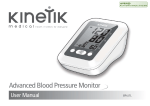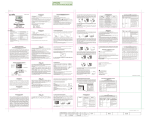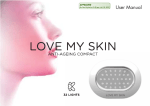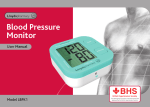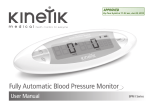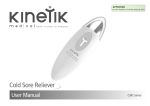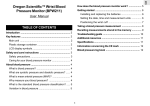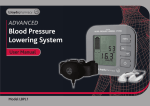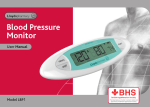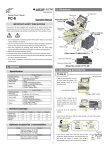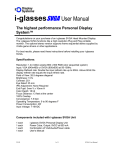Download Fully Automatic Blood Pressure Monitor
Transcript
By Paul Aylett at 2:09 pm, Jun 05, 2012 Fully Automatic Blood Pressure Monitor User Manual BPM1KTL Series Content Introduction 2 Parts 3 Setting up your Blood Pressure Monitor Loading Battery Connecting the Cuff Clock and Date Adjustment 4-6 4 4 5 Backlight Indicator and Classification of Blood Pressure 6 Irregular Heart Beat 7 Using your Blood Pressure Monitor Your first test Putting on the Cuff Washing Instruction Start Measuring Process 8-16 8 9 9 10 12 Memory Displaying Stored Results Deleting Measurements from the Memory What the results mean Re-measuring Shut Down 13 13 14 15 16 16 Additional Information on Blood Pressure 17 Specification 18 Abnormality & Troubleshooting 19-20 Maintenance 21 Blood Pressure Record Table 22 Explanation of symbols on unit 23 Introduction Thank you for buying and using the Kinetik Medical Fully Automatic Blood Pressure Monitor. This monitor is an easy to use and accurate way to measure your blood pressure. Before you start, it is important to read this instruction manual. Blood pressure testing is easy. To get the most out of this product, please read this user guide carefully. We hope you will be satisfied with your Fully Automatic Blood Pressure Monitor. If you have any questions, please contact your local pharmacist or healthcare professional. 2 Parts Clock low battery Systolic deflate to measure (deflate air in cuff) Diastolic irregular heartbeat Rubber tubule plug fully automatic BLOOD PRESSURE MONITOR IHB start LCD Cuff Rubber tubule memory / select Start Memory / Select Setting up your Blood Pressure Monitor Loading Batteries a. Open the battery cover on the base of the monitor. Replacing Batteries b. Insert four “AAA” batteries, observing correct polarity. • When the LCD screen displays ‘low battery’ c. Close the battery door. new batteries must be inserted immediately Non-rechargeable batteries are not to be recharged. • to ensure accurate results. • Exhausted batteries are to be removed from the monitor. Please dispose of batteries according to battery • The supply terminals are not to be short circuited. • manufacturer’s instructions. • Do not mix old and new batteries or different types of batteries. Do not use rechargeable batteries. Only batteries of the same or equivalent type as recommended are to be used. Batteries must be handled with care under adult supervision. If batteries leak and come into contact with skin or eyes, wash immediately with copious amounts of water. BPM1KTL Connecting the Cuff a. Insert the plug end of the rubber tubule firmly into the cuff socket located on the front of the monitor to ensure there is no air leakage. b. The cuff should be ready to use. Ensure that the end is passed through the metal loop and the hook and loop fastening is facing outwards. NOTE: Cuff supplied. fully automatic BLOOD PRESSURE MONITOR IHB start memory / select Setting up your Blood Pressure Monitor Clock and Date Adjustment a. Once you install the battery or turn off the monitor, it will enter standby mode, and LCD will alternate between time and date. b. While the monitor is in standby, press and hold both the ‘start’ and ‘memory’ buttons simultaneously until the green backlight comes on and the month digit starts to blink. Press the ‘memory’ button repeatedly (or press and hold for rapid advance) to select the correct month. Once done, press the ‘start’ button to confirm. The month is now set and you can begin to select the correct day, again using the ‘memory’ button to select and the ‘start’ button to confirm. Repeat the procedure for setting the hour and minutes. When finished, the monitor will return to standby mode. c. The monitor will turn off automatically after 1 minute of no operation, with the time and date unchanged. d. Once you change the batteries, you should readjust the time and date. Note: when you adjust the clock and date, the backlight always is green. 5 Backlight Indicator and Classification of Blood Pressure The backlight will change according to your measured result. The table below shows the different blood pressure classifications as defined by the British Hypertension Society and the corresponding backlight colour. Please note that factors such as smoking, obesity & diabetes will affect your blood pressure. Always consult your physician or healthcare professional before starting a diet or exercise regime. Classification of Blood Pressure Levels Systolic BP (mmHg) Diastolic BP (mmHg) Backlight Colour Low * Optimal Normal High-normal Grade 1 Hypertension Grade 2 Hypertension Grade 3 Hypertension 90 91–119 120–129 130–139 140–159 160–179 180 or 60 and 61 - 79 and 80 -84 or 85 - 89 or 90 - 99 or 100–109 or 110 Flashing green/amber Green Green Amber Flashing Amber Red Flashing red * Low blood pressure, or hypotension, occurs when blood pressure during and after each heartbeat is much lower than usual. This means the heart, brain, and other parts of the body do not get enough blood. Symptoms may include blurry vision, confusion, dizziness, fainting, light-headedness, sleepiness & weakness. However, blood pressure that is borderline low for one person may be normal for another. Consequently, hypotension in a healthy person that does not cause any problems usually doesn't require treatment. If in doubt, seek advice from your physician or healthcare professional. Note: The backlight indicator and the colours used are designed to indicate the various classifications of blood pressure only. The use of the colours Amber or Red should not be interpreted as a medical emergency. 6 Irregular Heart Beat This monitor can detect possible irregular heart beat (cardiac arrhythmia) disorders during measurement and if detected indicates the detection with the flashing icon . Arrhythmia is a condition where the heart rhythm is abnormal as a result of defects in the bioelectrical system that controls the beating of the heart. The symptoms (premature or omitted heart beats, slow or excessively fast heart rate) may be caused by heart disease, age, physical predisposition, excessive use of stimulants, stress or lack of sleep. Arrhythmia can only be ascertained through examination by your doctor. Repeat the measurement if the flashing icon is displayed. Please note that you should rest for 5 minutes between measurements and not talk or move during the measurement. If the icon appears often, please contact your doctor. Any self-diagnosis and treatment based on the test results may be dangerous. It is vital to follow your doctor‘s instructions. Note: This monitor is designed to detect Premature Ventricular Contractions, also known as a Premature Ventricular Complex (or complexes), Ventricular Premature Contractions (or complex or complexes), Ventricular Premature Beats, or Extrasystoles. It is not designed to detect Atrial Fibrillation or Atrial Premature Beats. 7 Using your Blood Pressure Monitor Your First test The British Hypertension Society (BHS) recommends that for your first test you test both your arms. (Note: Ensure you do not suffer from any medical conditions which will prevent you from having your blood pressure measured in both arms). This will determine which arm should be used for future measurements. Take note of your systolic (higher number) reading on both arms. The arm which gives the higher systolic reading should be used in the future for testing. Example Left arm: 132 86 Right arm: 128 84 (systolic) (diastolic) (systolic) (diastolic) Then use your left arm for future testing. 8 Using your Blood Pressure Monitor Putting on the Cuff a b c a. Place the cuff 1~2cm above the elbow joint. Measuring can be done on light clothing such as a shirt or blouse. However, if you have a weak pulse, it is recommended you test on a bare arm. Remove any tight or restrictive clothing from your arm. For example, restriction caused by rolling up shirt sleeve. b. Place hand on a flat surface with the palm facing up and with the rubber tube running down the center of the arm. c. Turn the cuff end outwards and tighten it by pulling it through the metal loop and pressing the hook surface of the cuff on to the loop surface of the cuff. To get the correct tightness of the cuff, you should be able to fit two fingers under the cuff. Concerned about which arm to use? Please refer to ‘Your first test’ on page 8. d. Use your free hand to adjust the tightness of the cuff until it is firm. Washing Instructions The cuff can be cleaned by hand with warm, soapy water. Rinse thoroughly with cold water and towel dry. DO NOT IRON. 9 Using your Blood Pressure Monitor Start a. We recommend that you carry out your test whilst sitting at a table with both of your feet flat on the floor (ensuring the cuff is at the same height as your heart). This will place your arm and the monitor in . results. an ideal position for the best b. Place the cuff on your selected arm. After applying the cuff and your body is in a comfortable position, press the ‘start’ button. A beep is heard and all display characters are shown for self-test and the backlight is green. Please contact the service center if any segments are missing. c. Then the last used memory bank (U1 or U2) will blink. Press ‘memory’ button to change over to other bank. Confirm your selection by pressing ‘start’ button. The current bank can also be confirmed automatically after 5 seconds with no operation. 10 Using your Blood Pressure Monitor d. After selecting the memory bank, the monitor starts to seek zero pressure. e. The monitor inflates the cuff until sufficient pressure has built up for a measurement. Then the monitor slowly releases air from the cuff and carries out the measurement. Finally the blood pressure and pulse rate will be calculated and displayed on the LCD screen separately. The irregular heartbeat symbol (if any) will be displayed on the LCD. The result will be automatically stored in the current memory bank. f. After measurement, the monitor will turn off automatically after 1 minute of no operation. Alternatively, you can press the ‘start’ button to turn off the monitor manually. g. During measurement, you can press the ‘start’ button to turn off the monitor manually. • Please consult a health care professional for interpretation of pressure measurements. • When the monitor displays the measurement results, the backlight will show a different color according to the systolic and diastolic pressures. Refer to the “Backlight Indicator and Classification of Blood Pressure” section. 11 Using your Blood Pressure Monitor Measuring Process a. Once the cuff has automatically inflated, the LCD screen will display whilst the pressure is gradually reduced and the monitor takes an automatic measurement. b. The monitor will beep when the automatic measurement has finished. • If there is an error or abnormal reading, please refer to the “Abnormality & Troubleshooting” section. 12 Using your Blood Pressure Monitor Memory The memory can store 2 users x 30 sets of measurements. The results will be automatically stored. Once the memory has been filled with 30 sets of data, the 31st measurement when taken will be stored as the most recent reading whilst the first reading you took will be automatically deleted. To delete all stored results, press ‘memory’ once to memory mode. Press and hold ‘memory’ for 3 seconds. All results will be deleted. Displaying Stored Results To check the readings held in the memory, press the ‘memory’ button from standby mode. Press the ‘start’ button to toggle between user1 (U1) and user 2 (U2) then press ‘memory’ again to select. You can now press the ‘memory’ button repeatedly to review each reading stored in the selected memory bank. Press the ‘start’ button to return to standby mode. 13 Using your Blood Pressure Monitor Deleting Measurements from the Memory To delete the measurements from a memory bank, select the memory bank from standby mode by pressing the ‘memory’ button. Use the ‘start’ button to select U1 or U2, then press the ‘memory’ button once again to confirm. Press and hold the ‘memory’ button until 3 beeps are heard. The memory bank has now been cleared. Press the ‘memory’ or ‘start’ button to return to standby mode. 14 Using your Blood Pressure Monitor What the results mean a. The LCD screen will automatically display the systolic and diastolic pressure reading in mmHg and the pulse rate in pulse/min after each measurement. b. Record the date, time, systolic reading, diastolic reading and pulse rate on your record card which you will find in the back of the user manual (including anything which may have influenced your blood pressure reading e.g. stress, anxiety). This will help you monitor trends. Please take this record card with you on your visits to your doctor or healthcare professional. • Measurements should ideally be taken at the same time, under the same conditions and in the same position each time. Please be aware that blood pressure can fluctuate since it responds to minute changes in the body. It is unusual to continuously remain at the same value, hence it is recommended that the blood pressure be determined based on an average of multiple measurements. If you experience a higher than normal reading, do not panic as this can happen. Relax and take a break for at least 10 minutes before measuring your blood pressure again. Low blood pressure (Hypotension) and high blood pressure (Hypertension) can only be diagnosed by a qualified healthcare professional, such as a doctor or pharmacist. If you have any concerns or questions, please contact your pharmacist or healthcare professional. To get an accurate value: • Measure one hour after eating and avoid measuring immediately after bathing. • Measure one hour after smoking or drinking alcohol/coffee. • Relax for 10-20 minutes before taking a measurement and remain relaxed. whilst measuring. • Do not move or talk during measurement, as this will affect the accuracy. 15 Using your Blood Pressure Monitor Re-measuring If you want to measure again, press ‘start’ button to switch off and press ‘start’ button again. • Leave at least three minutes between measurements to allow blood circulation to the arm to return to normal. • Do not measure your blood pressure too many times in one session as it may cause discomfort in the arm. • If you feel any discomfort or pain, turn the monitor off and remove the cuff immediately. Shut Down Please turn the unit off after measurement if not re-measuring. • The unit has an automatic ‘switch off’ mechanism which means it will turn off after 1 minute if not being used. 16 Additional Information on Blood Pressure Your heart is just like a pump which works all the time to make the blood flow through all blood vessels. Blood pressure measures the force on the wall of the blood vessels caused by the pressure of the blood. The output of blood from the heart when it pushes blood around the body is called systolic blood pressure. Diastolic blood pressure is the measurement of the blood returning to the heart. Blood pressure is normally written as, for example: 120 (systolic) 80 (diastolic) Fluctuation of Blood Pressure Blood pressure fluctuates constantly during the day. Its value in the day time is higher than in the evening with the lowest level being at midnight. The pressure begins to rise again at 03:00am and reaches its highest level any time during the day – so it is impossible to get a consistent reading. For this reason, please take your measurements at the same time of day. Systolic 17 Diastolic Specification (1) (2) (3) (4) (5) (6) Model: BPM1KTL Digital display system Measuring method: Oscillometric method Memory: 2 users x 30 readings Measuring Accuracy: Within±3mmHg Blood pressure Measuring range: 30mmHg~280mmHg (7) Pulse rate range: 40~180/min (8) Pulse rate accuracy: Within±5% (9) Power source: DC6V type 4 x AAA size batteries (10) Classification: Internal powered Equipment Type B (11) Pressurisation: automatic air inflation by an air pump (12) Deflation: Automatic exhaust (13) Automatic power off: To be automatically cut off after 1 minute of non use to save energy. (14) Battery life: Approx. 2 months with 3 times usage per day (15) Environmental temperature for using: 5~40 ºC (16) Environmental temperature for storage: -20~55 ºC (17) Environmental humidity for using: <90% (18) Environmental humidity for storage: <95% (19) Transport condition: Humidity range: Less than 95% Ambient temperature range: -5~40 ºC This is a class IIa medical device and fulfils the provisions of the medical devices directive 93/42/EEC. Blood pressure measurements determined with this device are equivalent to those obtained by a trained observer using the cuff/stethoscope auscultation method, within the limits prescribed by EU standard EN1060 non invasive sphygmomanometers. 18 Abnormality & Troubleshooting Abnormality The cuff does not inflate or the display shows low pressure during inflation LCD screen shows battery symbol LCD screen shows abnormal result No response when buttons pressed LCD shows “Er 0” Reason Action Pressure loss due to air leakage in socket or cuff. Socket is not connected properly. Check the connection between the socket and monitor. Reconnect the socket properly. Batteries are low. Change the batteries - refer to the ‘Loading the Batteries’ section. Tighten the cuff and refer to the section ‘Setting up your Blood Pressure Monitor’. Re-test. Do not speak and take 2-3 deep breaths before to relax. Stay calm and remain steady. Cuff is not tight or is positioned incorrectly. User was excited/nervous or spoke/moved during measurement. Wrong position. Adjust your position - refer to page 9. Some interference during inflation or incorrect operation during measurement. Incorrect operation. Refer to the section ‘Using your Blood Pressure Monitor’. LCD shows “Er 1” Pressure system is unstable before measurement. Systolic pressure detect fail. LCD shows “Er 2” Diastolic pressure detect fail. 19 Take out the batteries for a few minutes, then re-insert them, following directions in section‘Loading the Batteries’. Don’t move and try again. Abnormality & Troubleshooting LCD shows “Er 3” Pneumatic system blocked or cuff is too tight during inflation. LCD shows “Er 4” Pneumatic system leakage or cuff is too loose during inflation. LCD shows “Er 5” Inflation above 300mmHg. LCD shows “Er 6” Over 3 minutes while pressure above 15 mmHg. LCD shows “Er 7” EEPROM accessing error. LCD shows “Er 8” Device parameter check error. LCD shows “Er A” Pressure sensor parameter error. No response when you press button or load battery. Incorrect operation or strong electromagnetic interference. Note: If the LCD shows low battery symbol Position the cuff correctly and try again. Measure again after 5 minutes. If the monitor is still abnormal, please contact your local retailer. Take out batteries for five minutes, and then reinstall all batteries. or error message, the backlight is amber. 20 Maintenance 1. Do not drop this blood pressure monitor or subject it to strong impact. 2. Avoid exposure to high temperatures, direct sunlight and contact with water. 3. If the monitor is stored at temperatures below freezing, do not use immediately. Leave at room temperature for at least one hour before use. 4. Do not attempt to disassemble the monitor. 5. Do not leave the batteries in the monitor if it is not in use for a long period of time. 6. It is recommended that the performance of the monitor should be checked every 2 years and after main maintenance and repair. 21 Blood Pressure Record Table Please log the date, time and your SYS (systolic) and DIA (Diastolic) blood pressure levels. We recommend you share this information with your Doctor 22 Explanation of symbols on unit Read the instructions. This symbol indicates that this product is a Type BF device. Symbol for "Environment Protection" – Waste electrical products should not be disposed of with household waste. Please recycle where facilities exist. Check with your local Authority or retailer for recycling advice. Symbol for “Manufacturer”. 0197 This product complies with MDD93/42/EEC requirements. Symbol for “European Representative”. Harvard Medical Devices Ltd. Units 1301-2, 13th Floor, Railway Plaza, 39 Chatham Road South Tsimshatsui, Kowloon, Hong Kong. Kinetik Medical Devices Ltd. Harvard House, The Waterfront, Elstree Road, Elstree, Herts WD6 3BS, UK 25 0197 BPM1KTL IB UK 20120524
























